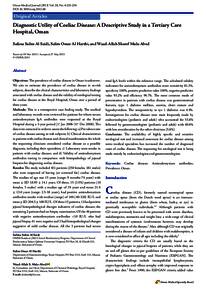Document
Diagnostic Utility of coeliac disease : a descriptive study in a tertiary care hospital, Oman.
Identifier
DOI 10. 5001/omj.2013.68
Contributors
Al-Harthi, Salim Omar., Author
Mula-Abed, Waad-Allah S., Author
Publisher
Oman Medical Specialty Board.
Gregorian
2013-07
Language
English
English abstract
Objectives: The prevalence of coeliac disease in Oman is unknown. We aim to estimate the prevalence of coeliac disease in at-risk subjects, describe the clinical characteristics and laboratory findings associated with coeliac disease and the validity of serological testing for coeliac disease at the Royal Hospital, Oman over a period of three years.
Methods: This is a retrospective case finding study. The medical and laboratory records were reviewed for patients for whom serum antiendomysium IgA antibodies were requested at the Royal Hospital during a 3-year period (1st Jan 2006-31st Dec 2008). The data were extracted in order to assess the following: a) Prevalence rate of coeliac disease among at-risk subjects; b) Clinical characteristics in patients with coeliac disease and clinical manifestations for which the requesting clinicians considered coeliac disease as a possible diagnosis, including their specialties; c) Laboratory tests results in patients with coeliac disease; and d) Validity of antiendomysium antibodies testing in comparison with histopathology of jejunal biopsies for diagnosing coeliac disease.
Results: The study included 431 patients (250 females, 181 males) who were suspected of having (or screened for) coeliac disease. The median of age was 15 years (range: 9 months-74 years) with mean ± SD 18.95 ± 14.1 years. Of these, 15 (3.5%) patients (10 females, 5 males) with a median age of 19 years and mean 21.4 ± 13.0 years (range: 2.5-38 years), had positive antiendomysium antibodies results with median (range) of 160 (40-320) IU/L and mean± SD 204.5 ± 160 IU/L. Of these 15 patients, 13 had positive jejunal histopathological changes indicative of coeliac disease; the remaining 2 patients had no biopsy examination. Of the 44 patients with negative antiendomysium antibodies <10 IU/L who had jejunal biopsy, 41 were negative and 3 had histopathological changes suggestive of mild coeliac disease. All the 3 patients had serum total IgA levels within the reference range. The calculated validity indicators for antiendomysium antibodies were: sensitivity 81.3%, specificity 100%, positive predictive value 100%, negative predictive value 93.2% and efficiency 94.7%. The most common mode of presentation in patients with coeliac disease was gastrointestinal features, type 1 diabetes mellitus, anemia, short stature and hypothyroidism. The seropositivity in tye 1 diabetics was 4.9%. Investigations for coeliac disease were most frequently made by endocrinologists (pediatric and adult) who accounted for 53.8% followed by gastroenterologists (pediatric and adult) with 40.6% with less consideration by the other clinicians (5.6%).
Conclusion: The availability of highly specific and sensitive serological test and increased awareness for coeliac disease among some medical specialties has increased the number of diagnosed cases of coeliac disease. The requesting for serological test is being made mainly by endocrinologists and gastroenterologists.
Member of
Resource URL
Category
Journal articles

